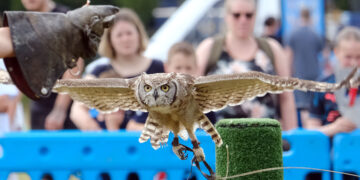July is the month of high summer and the garden comes alive during hot lazy afternoons to the sound of bees buzzing, gathering pollen from all the plants you have lovingly nurtured and cared for that are now in full flower.
Although one of the quietest months from the point of view of garden birds, it is one of the best months for insects, especially butterflies.
The average garden, with a few good nectar plants, could have 15 or more species visiting this month. In addition to nectar-rich plants such as buddleia, verbena bonariensis and wild marjoram butterflies love nettles.
While it may be tempting to remove your flowering nettle patch, try to leave some as they provide one of the most important foods for caterpillars of butterflies such as the red admiral.
The Big Butterfly Count (organised by Butterfly Conservation www.butterflycount.org) is running from July 12 to August 4 this year and is a lovely way to spend time watching butterflies and helping to collect data for conservation.
If you have buddleia in your garden then spotting butterflies will be easy.
Otherwise known as the ‘butterfly bush’, buddleia is one of the best nectar shrubs you can plant for butterflies.
Beautifully scented and with purple, pink, yellow or white flowers, it attracts a wide variety of butterfly species, including red admiral, peacock and small tortoiseshell. The Buddleja davidii, Buddleja x weyeriana and Buddleja globosa varieties are the best options.
Although a valuable resource for pollinators, care should be taken to stop buddleia from self-seedling and spreading beyond the garden, where it can ‘elbow out’ native plants nearby.
This can be avoided by deadheaded buddleia immediately after flowering.
A Royal Horticultural Society trial from 2010-12 showed that deadheading not only improved the appearance of the plant but also extended the period of flowering and helped to prevent seedlings spreading.
Apart from dead-heading buddleia, other top jobs for gardeners this month include:
-
Deadhead bedding plants and repeat-flowering perennials, to ensure continuous flowering. It keeps plants looking attractive and encourages more blooms, whether in beds and borders, containers or hanging baskets.
-
Use grey water – in a drought, recycled water from baths, sinks and showers can be a vital resource. Use within 24 hours to prevent bacterial growth and apply to ornamental plants rather than edibles.
-
Pick your courgettes before they turn into marrows and plant out leeks and brassicas for a winter supply – plus keep an eye out for potato blight and tomato blight.
Plus, here’s what the experts have to say …
This is often one of the hottest months of the year and a great time to sit out and enjoy your garden.
Keep plants looking good by regularly dead-heading, and you’ll enjoy a longer display of blooms. Make sure you keep new plants well watered, using grey water where possible, and hoe off weeds, which thrive in the sunshine.
RHS
July is the month when all the hard work pays off. Herbs and flowers are fragrant, and the soil rich with your homemade compost. After the rush of May and June growth, you can relax a little and enjoy the fruits of your labour.
Garden Organic
Now is the best time to cut and tie stems of herbs – including oregano, marjoram, thyme and lavender – for use in winter. Cut stems in the morning on a dry day, tie them into small bundles of individual herbs and hang up in a cool, dry room. When well dried, the leaves should be transferred to tightly closing tins, or Kilner-type jars.
Country Life











































